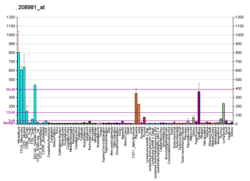Structure
PECAM-1 is a highly glycosylated protein with a mass of approximately 130 kDa. [9] The structure of this protein was determined by molecular cloning in 1990, when it was found out that PECAM-1 has an N-terminal domain with 574 amino acids, a transmembrane domain with 19 amino acids and a C-terminal cytoplasmic domain with 118 amino acids. The N-terminal domain consists of six extracellular Ig-like domains. [10]
Interactions
PECAM-1 is a cell-cell adhesion protein [11] which interacts with other PECAM-1 molecules through homophilic interactions or with non-PECAM-1 molecules through heterophilic interactions. [12] Homophilic interactions between PECAM-1 molecules are mediated by antiparallel interactions between extracellular Ig-like domain 1 and Ig-like domain 2. These interactions are regulated by the level of PECAM-1 expression. Homophilic interactions occur, only when the surface expression of PECAM-1 is high. Otherwise, when expression is low, heterophilic interactions occur. [13]
Tissue distribution
CD31 is normally found on endothelial cells, platelets, macrophages and Kupffer cells, granulocytes, lymphocytes (T cells, B cells, and NK cells), megakaryocytes, osteoclasts, and brown adipocytes. [14]
Function
PECAM-1 is found on the surface of platelets, monocytes, neutrophils, and some types of T-cells, and makes up a large portion of endothelial cell intercellular junctions. The encoded protein is a member of the immunoglobulin superfamily and is likely involved in leukocyte transmigration, angiogenesis, and integrin activation. [5] CD31 on endothelial cells binds to the CD38 receptor on natural killer cells for those cells to attach to the endothelium. [16] [17]
Role in signaling
PECAM-1 plays a role in cell signaling. In the cytoplasmic domain of PECAM-1 are serine and tyrosine residues which are suitable for phosphorylation. After the tyrosine is phosphorylated, PECAM-1 recruits Src homology 2 (SH2) domain–containing signaling proteins. These proteins can then initiate signaling pathways. Of all these proteins, the protein most widely reported as interacting with the PECAM-1 cytoplasmic domain is SH2 domain–containing protein-tyrosine phosphatase SHP-2. [18] Signaling through PECAM-1 leads to the activation of neutrophils, monocytes and leukocytes. [19]
Leukocyte transmigration
PECAM-1 is involved in migration of monocytes and neutrophils, [20] natural killer cells, [21] Vδ1+ γδ T lymphocytes [22] and CD34+ hematopoietic progenitor cells [23] through the endothelial cells. Moreover, PECAM-1 is involved in transendothelial migration of recent thymic emigrants to the secondary lymphoid organs. [24] Mechanism of leukocyte transmigration can be explained by creating a homophilic interaction. In this interaction migrating leukocytes express PECAM-1 on the surface and then they react with PECAM-1 on the surface of endothelial cell. [25]
Angiogenesis
PECAM-1 is also important for angiogenesis because it enables the formation of new blood vessels through the cell-cell adhesion. [26]
Role of CD31 in diseases
Atherosclerosis
Inhibition of PECAM-1 leads to a reduction of atherosclerotic lesions in mice. [31] That means that PECAM-1 is involved in atherosclerosis. The exact mechanism, how PECAM-1 contributes to atherosclerosis is not known, but there are some theories. PECAM-1 can act as a mechanoresponsive molecule. Or the pathogenesis can be caused by the infiltration of leukocytes mediated by PECAM-1. Finally, polymorphisms in the PECAM-1 gene can lead to the progression of atherosclerosis. [32]
Neuroinflammation
PECAM-1 contributes to at least two of the nervous system diseases, multiple sclerosis and cerebral ischaemia. First signs of multiple sclerosis are defects in the blood brain barrier and leukocyte migration mediated by adhesion molecules such as PECAM-1. Moreover, monocytes in patients with multiple sclerosis express high level of PECAM-1. Cerebral ischaemia is caused by the accumulation of leukocytes, which then infiltrate brain parenchyma and release toxic compounds such as oxygen radicals. Interactions between leukocyte and endothelium are mediated by PECAM-1. High levels of soluble PECAM-1 can be used to diagnose both diseases. Increased PECAM-1 levels indicate damage in the blood brain barrier in patients with multiple sclerosis and high PECAM-1 levels can be used as a short-term prediction of a stroke in patients with cerebral ischaemia. [34]
This page is based on this
Wikipedia article Text is available under the
CC BY-SA 4.0 license; additional terms may apply.
Images, videos and audio are available under their respective licenses.








